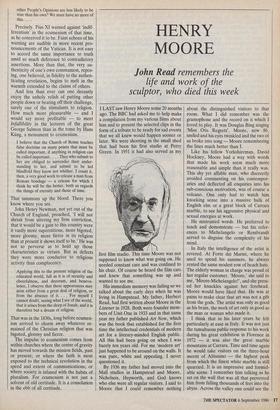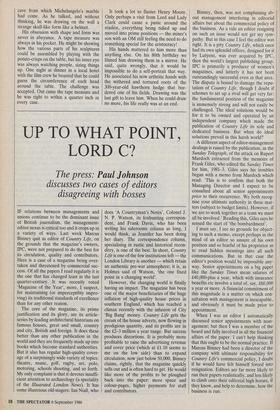HENRY MOORE
John Read remembers the
life and work of the sculptor, who died this week
I LAST saw Henry Moore some 20 months ago. The BBC had asked me to help make a compilation from my various films about him and to present the selected clips in the form of a tribute to be ready for sad events that we all knew would happen sooner or later. We were shooting in the small shed that had been his first studio at Perry Green. In 1951 it had also served as my first film studio. This time Moore was not supposed to know what was going on. He needed constant care and was confined to his chair. Of course he heard the film cars and knew that something was up and wanted to see me.
His immediate memory was failing so we talked about the early days when he was living in Hampstead. My father, Herbert Read, had first written about Moore in the Listener in 1928. Both were founder mem- bers of Unit One in 1933 and in that same year my father published Art Now, which was the book that established for the first time the intellectual credentials of modern art for a literary-minded English public. All this had been going on when I was barely ten years old. For me 'modern art' just happened to be around on the walls. It was pure, white and appealing. I never questioned it.
By 1936 my father had moved into the Mall studios in Hampstead and Moore, Nicholson, Hepworth, and God knows who else were all regular visitors. I said to Moore that I could remember nothing about the distinguished visitors to that room. What I did remember was the gramophone and the record on it which I loved to play. It was Douglas Bing singing `Miss Otis Regrets'. Moore, now 86, smiled and his eyes twinkled and the two of us broke into song — Moore remembering the lines much better than I.
Like his fellow Yorkshireman, David Hockney, Moore had a way with words that made his work seem much more reasonable and simple than it really was. This shy yet affable man, who discreetly avoided commenting on his contempor- aries and deflected all enquiries into his sub-conscious motivation, was of course a volcano. One only had to watch him knocking sense into a massive hulk of English elm or a great block of Carrara marble, to see his aggressive physical and sexual energies at work.
He mistrusted words. He preferred to teach and demonstrate — but his refer- ences to Michelangelo or Rembrandt served to disguise the complexity of his mind.
In Italy the intelligence of the artist is revered. At Forte dei Marmi, where he used to spend his summers, he always rented the same modest row of beach huts. The elderly woman in charge was proud of her regular customer. 'Moore,' she said to me, `Moore-Michelangelo, and she press- ed her knuckles against her forehead. Moore would have liked that. He was at pains to make clear that art was not a gift from the gods. The artist was only as good as his brain, the work of art only as good as the man or woman who made it.
I think that in his later years he felt particularly at ease in Italy. It was not just the tumultuous public response to his work during his great exhibition in Florence in 1972 — it was also the great marble mountains at Carrara. Time and time again he would take visitors on the three-hour ascent of Altissimo — the highest peak from which the finest white marble is still quarried. It is an impressive and formid- able scene. I remember him talking as he sat on the wall that was all that prevented him from falling thousands of feet into the abyss. Across the valley one could see the cave from which Michelangelo's marble had come. As he talked, and without thinking, he was drawing on the wall a strange skull-like form like a helmet.
His obsession with shape and form was never in abeyance. A tape measure was always in his pocket. He might be showing how the various parts of his sculptures could be assembled by playing with the potato-crisps on the table, but his inner eye was always watching people, sizing things up. One night at dinner in a local hotel with the film crew he boasted that he could guess the circumference of each head around the table. The challenge was accepted. Out came the tape measure and he was right to within a quarter inch in every case. It took a lot to fluster Henry Moore. Only perhaps a visit from Lord and Lady Clark could cause a panic around the studios, everything being tidied up and moved into prime positions — the miner's son with an OM still feeling the need to do something special for the aristocracy!
His hands mattered to him more than anything else. On his 80th birthday we filmed him drawing them in a mirror. He said, quite wrongly, that it would be impossible to do a self-portrait that way. He associated his now arthritic hands with the withered and tortured roots of the 300-year-old hawthorn hedge that bor- dered one of his fields. Drawing was the last gift to leave him. When he could draw no more, his life really was at an end.







































 Previous page
Previous page